Introduction
Florida has a unique and diverse aquaculture industry consisting of ornamental fish, food fish, shellfish, alligators, aquatic plants, and more. Although some aquatic plants are produced for food or wetland restoration, most production in Florida is for the aquarium and water garden industries. There are over 1000 different varieties of ornamental aquatic plants produced in Florida, most of which are grown in freshwater. Since most freshwater ornamental aquatic plants are tropical in origin, Florida’s warm climate is ideal for growing them year-round. This publication covers freshwater ornamental aquatic plant production in Florida including permitting and licensing, production techniques, farm design, pests and diseases, and marketing. This publication is written for the general public, high school students, and potential aquaculture producers interested in learning the basics of freshwater aquatic plant production.
Permitting/Prohibitions/Licensing
Aquatic plant production in the state of Florida is regulated by the Florida Department of Agriculture and Consumer Services, both the Division of Aquaculture (FDACS-DA) and the Division of Plant Industry (FDACS-DPI). Aquatic plant producers in Florida must have both an Aquaculture Certificate of Registration, obtained through the FDACS-DA, and a Certificate of Nursery Registration, obtained from FDACS-DPI. FDACS-DA reviews and inspects all Florida aquaculture facilities, including aquatic plant producers, ensuring compliance with the most recent Best Management Practices. FDACS-DPI is primarily concerned with regulating commercially propagated plants within the horticulture sector, including ornamental aquatic plant producers. Additionally, FDACS-DPI supervises the import and export of plants and regulates the movement of nursery stock into Florida to mitigate the introduction of regulated plant species and their associated pests and diseases.
Some non-native freshwater ornamental aquatic plants are regulated in Florida due to their invasive nature and established presence in the Florida environment (Table 1). Aquatic plants that are on the Florida Noxious Weeds List may not be cultivated, collected, possessed, sold, or imported under any circumstances. Three aquatic plant species are listed as “Prohibited Aquatic Plants.” These may not be collected from the wild or imported but can be cultivated at aquatic plant nurseries and exported out of state with approval from FDACS-DPI. A list of regulated aquatic plants is maintained by the National Plant Board. Producers should check this list to ensure they are following rules and regulations. Producers need approval from both FDACS-DA and FDACS-DPI before cultivating or possessing Prohibited Aquatic Plants, and both organizations should be notified when dealing with these plants to ensure compliance.
Types of Plants
Plants have four basic components: roots, stems, leaves, and flowers. Roots in aquatic plants are typically less developed than those in terrestrial plants but are still used for absorbing nutrients and anchoring the plant. Aquatic plant stems are used for support and transport of nutrients and water. Some modified stems, such as rhizomes and stolons, are also used for anchoring to the substrate. Leaves are the basis of photosynthesis and energy production. The flowers are used for sexual reproduction. Not all aquatic plants are flowering plants, and those that produce flowers typically do so above the water’s surface, to allow for insect pollination. However, some plants produce reduced flowers underwater whose seeds are designed for dispersal by water currents.
Aquatic plants can be roughly divided into four categories: submersed, emergent, floating-leaved, and floating (Figure1). Submersed plants grow completely underwater and cannot survive out of water. They typically have leaves that are thin and narrow; adapted to allow water to move easily between them and reduce tearing. Some submersed plants are rooted to the substrate or have rhizomes, or stolons, that keep them anchored. Other submersed plants are not attached and grow free-floating in the water column.
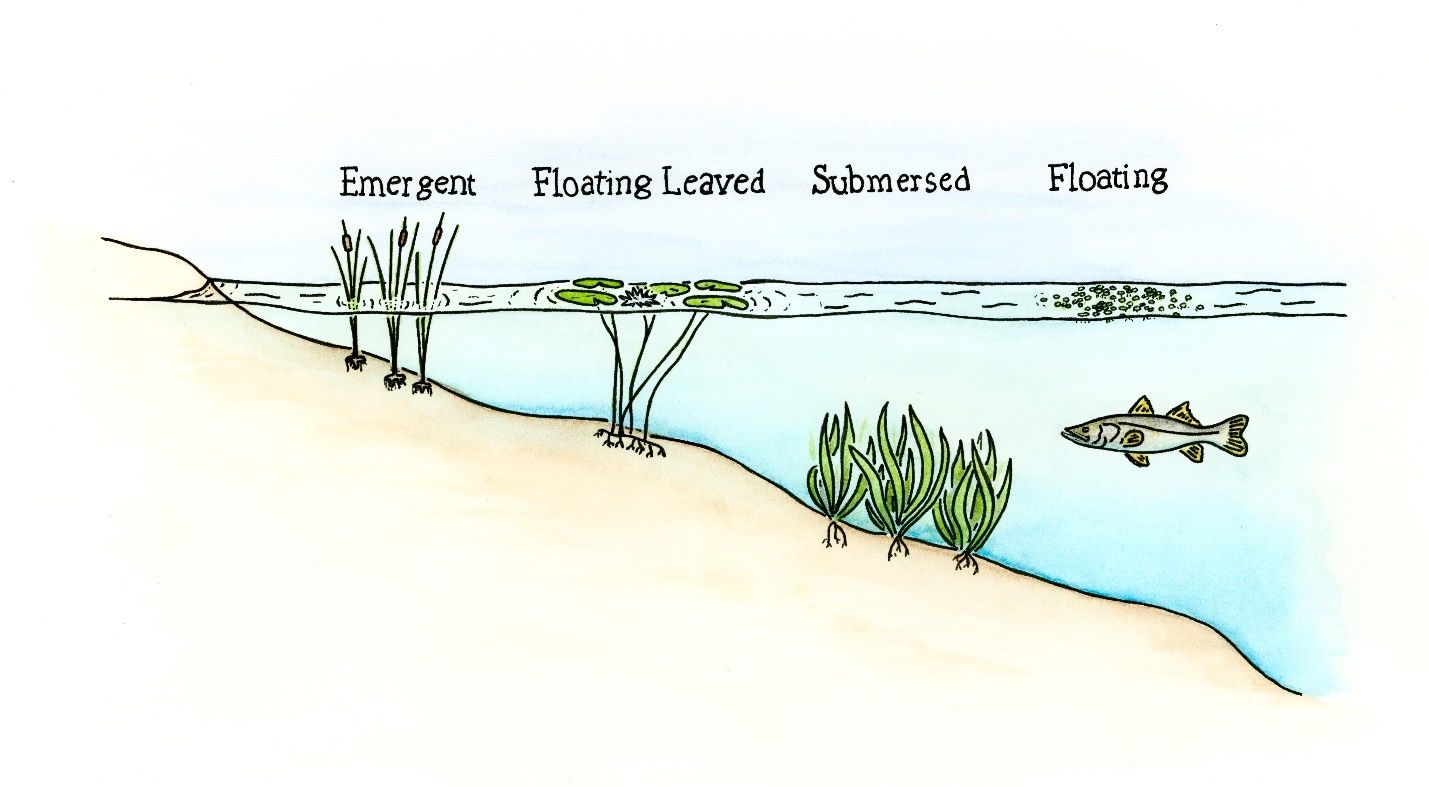
Credit: Joseph Henry, Triton Oceanic Exploration Society
Emergent plants are rooted to the underwater substrate. The plant then grows with its bottom portion underwater and top portion above water. Some emergent plants are considered amphibious and can grow completely out of water or completely submerged. Some amphibious plants are heterophyllous—hetero means different and phyllous means leaves. Heterophyllous plants can have leaves or other structures that look different when grown above or below water (Figure 2). Leaves of emergent aquatic plants grown above water are stronger and more robust than those grown underwater.

Credit: Lyn Gettys
Floating-leaved plants are attached to the substrate and have leaves and flowers that float on the surface of the water. Floating plants are not attached to the substrate; their leaves and flowers float on or just below the surface of the water and their roots dangle in the water column. Some floating plants also have reduced stems below or at the surface of the water. It is important to remember that morphology in aquatic plants is diverse and not all plants fall neatly into these four categories.
Plant Propagation Methods
Most freshwater aquatic plants in the ornamental trade are grown in a controlled environment. However, some are collected from the wild. Examples of wild freshwater plants collected in Florida include banana plant (Nymphoides aquatica) and swamp lily (Crinum americanum). When collecting wild plants, take care to preserve current populations for future harvests. Wild-collected plants are also subjected to native environmental conditions. This includes nutrient and water availability fluctuations due to seasonal changes and exposure to pests and diseases, which can harm other plants at the facility if biosecurity measures are not followed. For further information on collecting wild aquatic plants in Florida, including legalities, please visit Aquatic Plant Permit / Plant Industry Permits / Agriculture Industry / Home - Florida Department of Agriculture & Consumer Services (fdacs.gov).
Most producers propagate plants using asexual reproduction, which entails dividing groups of plants into smaller groups when they grow too large. Producers often grow bundles of plants specifically for this reason. Sexual reproduction, with seeds, may be necessary with some plants but is rarely used when not needed. The American lotus, Nelumbo lutea, is an example of a freshwater aquatic plant produced using seeds.
Vegetative Propagation
Differing methods of vegetative propagation are used to effectively grow freshwater ornamental aquatic plants. Some plants, such as hornwort (Ceratophyllum demersum) and lemon bacopa (Bacopa caroliniana), can be propagated from stem fragments. This entails cutting healthy stem tips into fragments approximately 10–15 cm (4–6 inches) long. The nodes on the stem fragment develop into roots, branches, and leaves, so selecting fragments with numerous nodes produces many new plants. Plant most of the stem fragment into appropriate soil, or media, with only the tip (~1 inch; 2–3 cm) breaking the surface. If planting into pots, multiple stem fragments can be planted into one pot and then split after new plants develop.
Many freshwater plants produce rhizomes or stolons (called runners), which are root-like stems that grow in or on the substrate. Along these runners, new “daughter” plants can form and grow. It is common to clip daughter plants directly from the parent’s runner and plant them into new pots or tanks. Multi-plant clumps can also be divided from the parent and planted into new pots. In both cases, it is advantageous to ensure that new plants have roots intact when replanting as they tend to dislodge easily from the substrate. Anchoring the new plant or using a dense soil ensures a more successful transplant. If nodes are present along the runners, they can also be clipped from parent plants and grown in a similar manner to stem fragments. Examples of freshwater plants that propagate using runners include Cryptocoryne spp., dwarf hairgrass (Eleocharis parvula), java fern (Microsorum pteropus), amazon sword plant (Echinodorus amazonicus), and eelgrass (Vallisneria americana) (Figure 3).
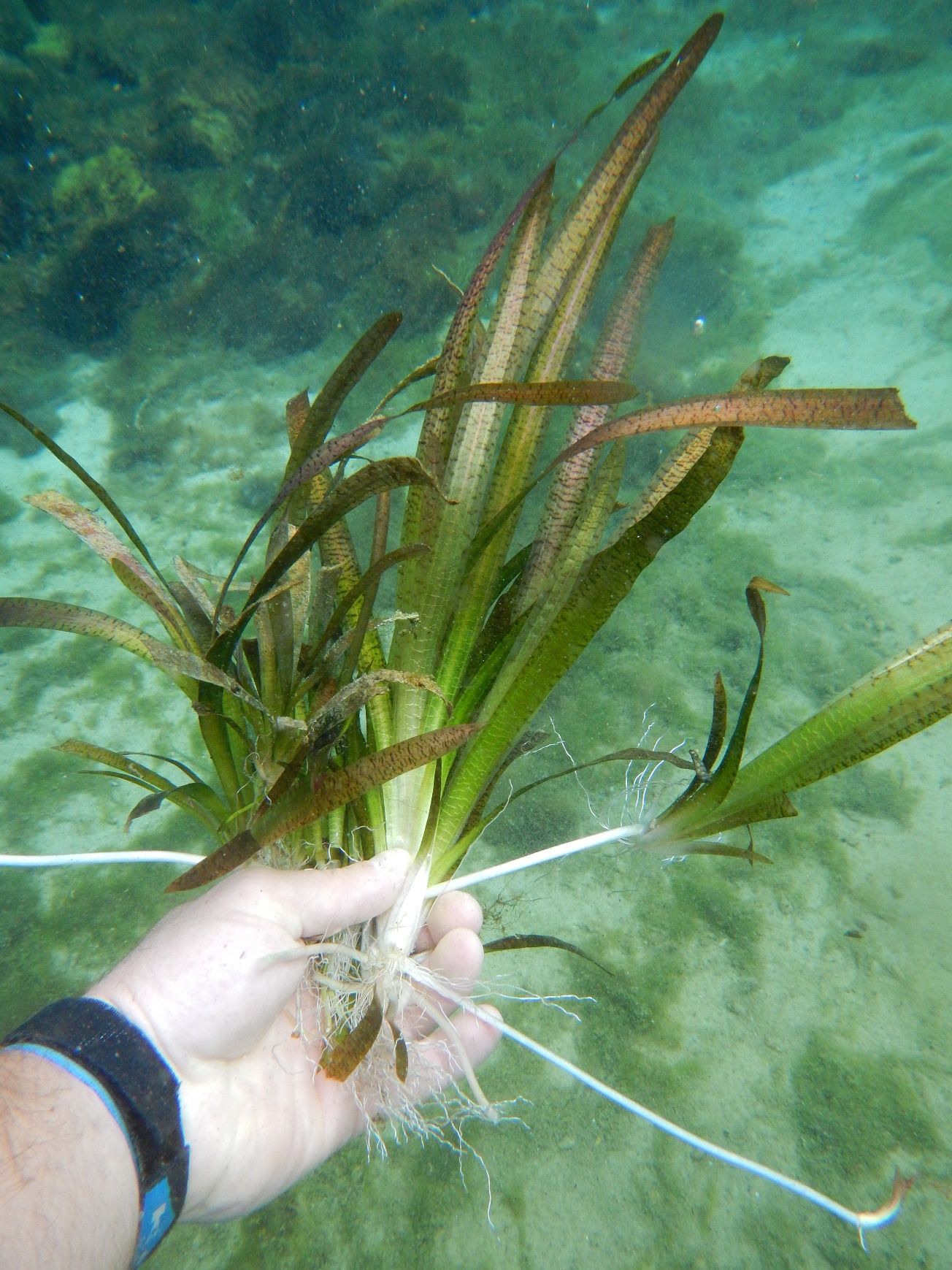
Credit: Lyn Gettys
Some freshwater plants produce bulbs or tubers, which are underground structures that store food and energy allowing them to survive extended periods of unfavorable conditions. Producers collect these bulbs and plant them directly or hold them in a dormant state, under refrigeration, until planting (~8 weeks). These plants can also be grown to produce bulbs for future propagation. Bulbs usually float, so they need to be buried or completely covered when planting. Examples of freshwater plants that produce bulbs are Madagascar lace (Aponogeton madagascariensis), onion plant (Crinum thaianum), and water lilies (Nymphaea spp.) (Figure 4).
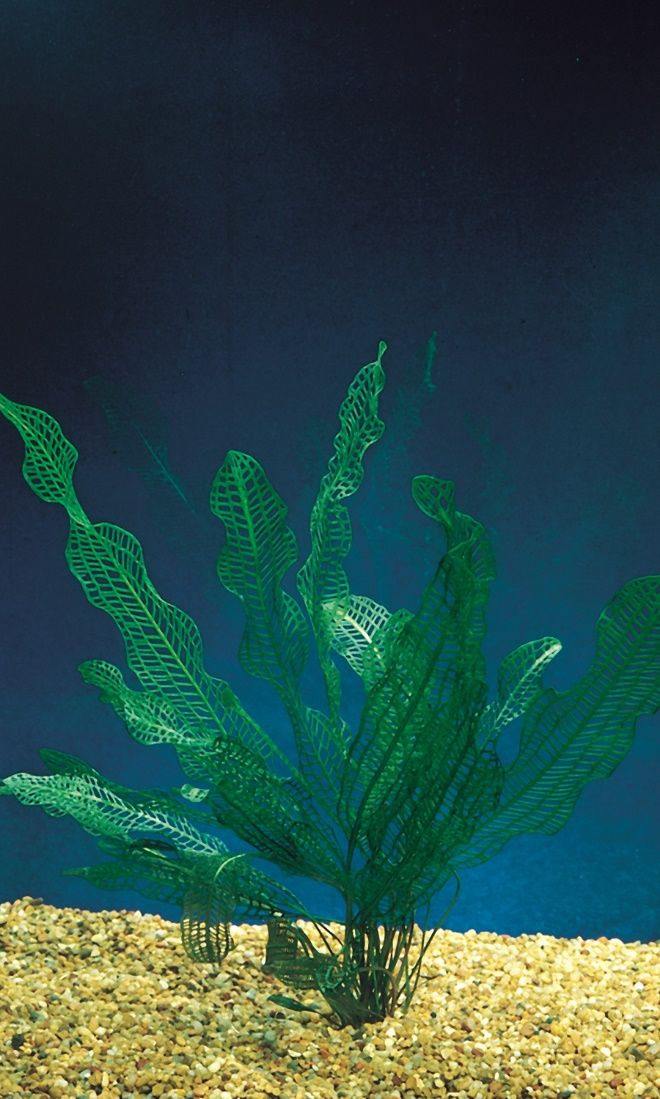
Credit: Florida Tropical Fish Farms Association
Tissue Culture Propagation
Most freshwater ornamental aquatic plant producers obtain and aquaculture their plants through vegetative propagation and/or wild collection. Some plants, particularly young starter plants, can also be obtained from facilities practicing tissue culture propagation, or micropropagation (Figure 5). Tissue culture propagation is a sterile, laboratory-based process that uses disinfection and cleanliness protocols to produce young starter plants. These starter plants are either sold to other facilities or grown in an extensive setting to market size. The benefit of growing or purchasing these plants is their relatively greater hardiness and initial freedom from disease, qualities they owe to the sterile environment in which they are produced. Freshwater ornamental aquatic plants propagated this way usually have a longer shelf life in the aquarium. This method is also advantageous in the production of unique hybrids within the industry. The drawback is that a significant amount of capital is required to purchase equipment and hire the labor necessary to operate a tissue culture propagation facility. Very few freshwater ornamental aquatic plant producers practice tissue culture propagation, but many will buy starter plants from facilities that do and produce propagules from those starters.
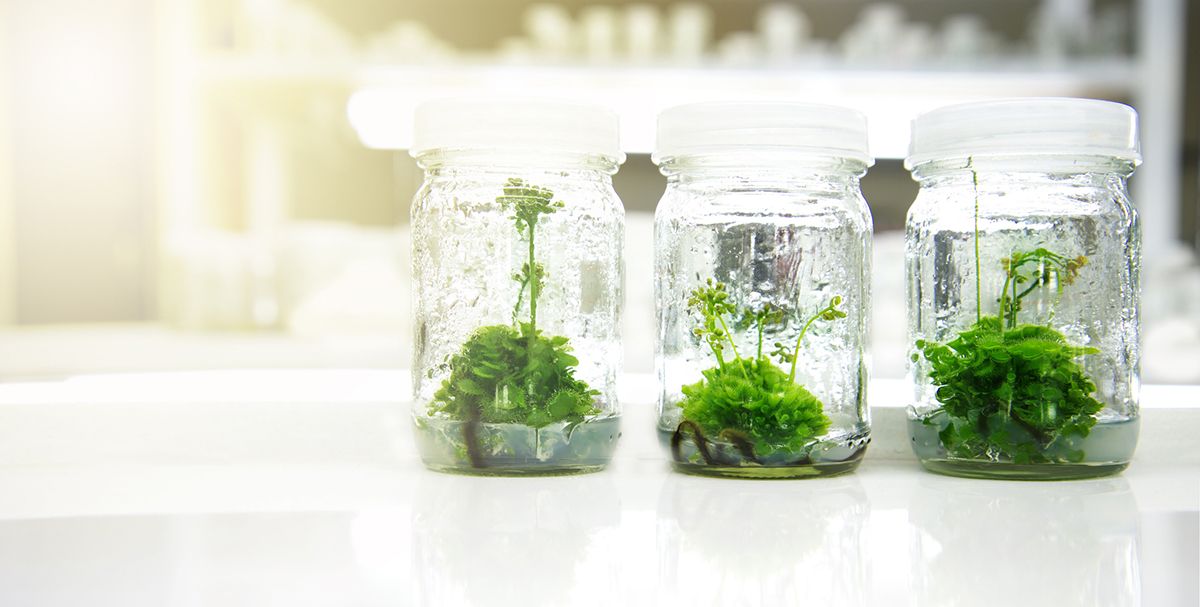
Credit: MadamLead/iStock/Getty Images Plus
Farm Design
Farm design is dictated by location, plant type, and production phases used. Most freshwater ornamental aquatic plants are tropical and require a warm climate and significant amounts of light. Most of the year, Florida is ideal for growing freshwater tropical plants, particularly in the middle to southern regions of the state. However, Florida winters are sub-tropical and most tropical plants should be housed in a warmer environment. Greenhouses, hoop houses, or buildings with removable siding are good for these growing conditions (Figure 6). Greenhouses are ideal for capturing heat during the day and holding it through the night during these colder periods. They also provide a barrier to keep out plant pests and diseases. During warmer months, the sides can sometimes be removed to cool the interior and provide comfort to workers in hot and humid conditions. Evaporative coolers installed in greenhouses are also an inexpensive way to cool the inside. An open structure can be used for some plants, but access to the environment comes with potential exposure to pests and diseases. Cooler locations require more heating costs, which needs to be considered when determining profitability.
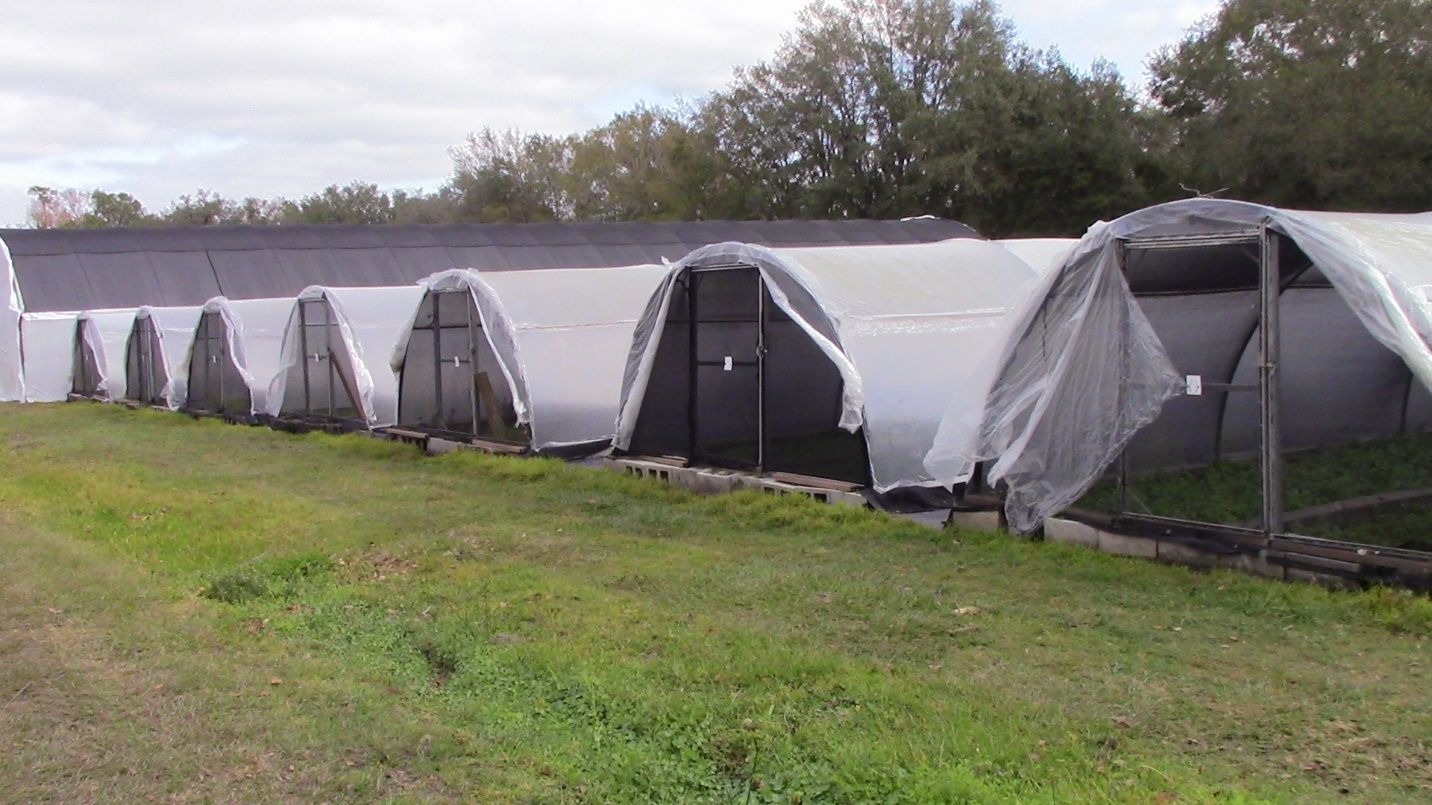
Credit: Eric Cassiano
One of the more important aspects to consider when growing freshwater ornamental aquatic plants is access to freshwater. You will want to use water coming from a well rather than water from a municipal water treatment plant. Treated water will have extra chemicals added to it that may harm or hinder the growth of aquatic plants and lack necessary nutrients needed by the plants. Depending on the location, you may also want to avoid water from a shallow well (30 feet or less) as it accesses surface water which may be contaminated with unwanted chemicals and pests. By using deeper well water, you avoid the need to treat the water prior to growing freshwater aquatic plants. Treatment protocol for municipal or shallow well water for use in freshwater aquatic plant aquaculture can vary depending on what the water contains, but it will likely require removing unwanted substances and adding needed nutrients back to the water, which can be costly. Well water will contain trace amounts of required nutrients (nitrogen and phosphorus) needed for freshwater aquatic plant production. However, depending on the plant species, you may need to add additional nutrients (fertilizer) to the water. An evaluation of your well water nutrient composition and an understanding of the needs of your target plant species is required to know how much additional fertilizer (if any) will be needed within your aquatic plant production facility. This will also dictate your water-use scenario. Depending on water composition, you may be able to fill production tanks when needed or you may be required to operate a continuous flow operation.
The freshwater plant types grown will determine the size and dimension of the growing tanks. Submersed, floating-leaved, and floating plants require more water than emergent plants. Submersed plants require approximately a foot or more of water depth to provide space for the plants to anchor (if needed), grow, and receive sunlight. Submersed plants grow completely underwater, so little space above the tank is needed beyond what it takes to work with the plants. Floating-leaved and floating plants need surface area to allow their leaves to spread out and receive sunlight at the water’s surface; an approximate water depth of one foot or less is adequate to develop underwater stem and root structures. Space above water should be provided to floating-leaved and floating plants for leaf and flower development, which occurs at and above the water’s surface. Emergent plants require very little water (~2 inches; ~5cm) but need more space above the water’s surface. Like floating-leaved and floating plants, emergent plants develop most of their leaves and flowers above water. Space should be provided for them to grow and be gardened. If applicable, most aquatic plants perform better when potted due to availability of nutrients and fertilizer. Because they are mostly out of water, emergent plants will also benefit from the increased stability of being potted.
Farm design is also determined by production phases used. Most facilities have dedicated space and equipment for raising propagules to market size, whether they were grown on-site or purchased from another facility. Many facilities reproduce some propagules on-site and purchase others. Reproducing propagules on-site is a complex process that demands additional space and labor, and tissue cell culture techniques require a significant amount of capital be dedicated to space, expertise, and equipment. You will need experienced personnel to achieve success. Understanding how you are going to produce aquatic plants helps design your farm and maps out the resources required to bring your crop to market size.
Regardless of the extent of your farm design, purchase and construct tanks that suit the needs of the plants and production facility. Concrete vaults and plastic tanks are suitable for growing aquatic plants. Tanks can also be constructed with wood and/or cinder blocks and plastic liners that allow for creation of specific sizes and depths (Figure 7). Vaults and tanks that house submersed, floating-leaved, and floating plants have a lot of water and are therefore heavy and should be on the ground. Emergent plants do not require much water, therefore growing tanks or trays can be constructed on raised tables at an adequate working height (Figure 8). This also provides storage space underneath the raised tables. Most producers do not use raised tables with multiple growing levels because the top level would block light from lower levels. Unlike other plant types, emergent plants are almost always potted with soil to help keep them stable and provide nutrients. Soil types will vary and are dependent on plant species need. Although a basic soil type will suffice for most plant species, understanding the needs of your target species will ensure you are providing the nutrients necessary for optimal growth.
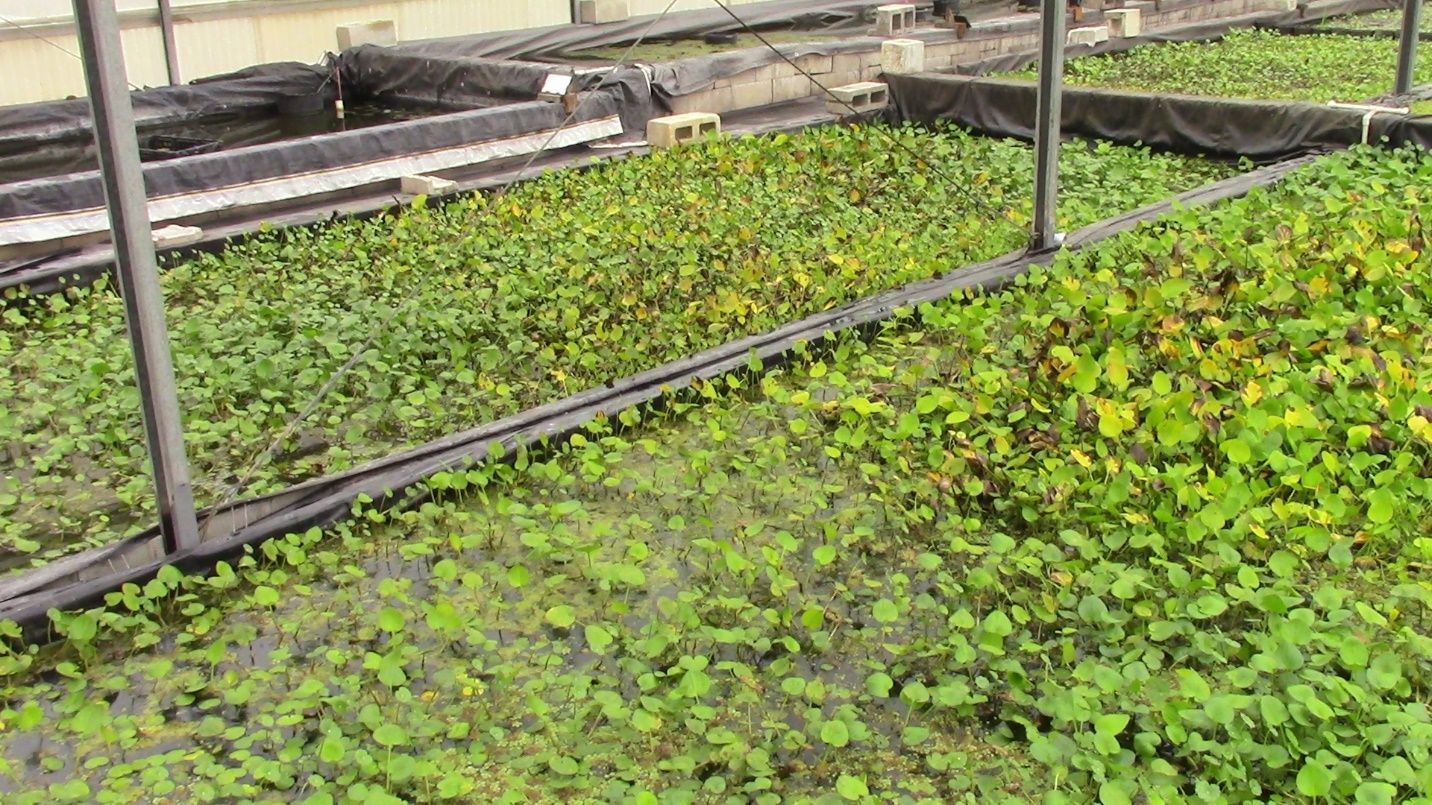
Credit: Eric Cassiano
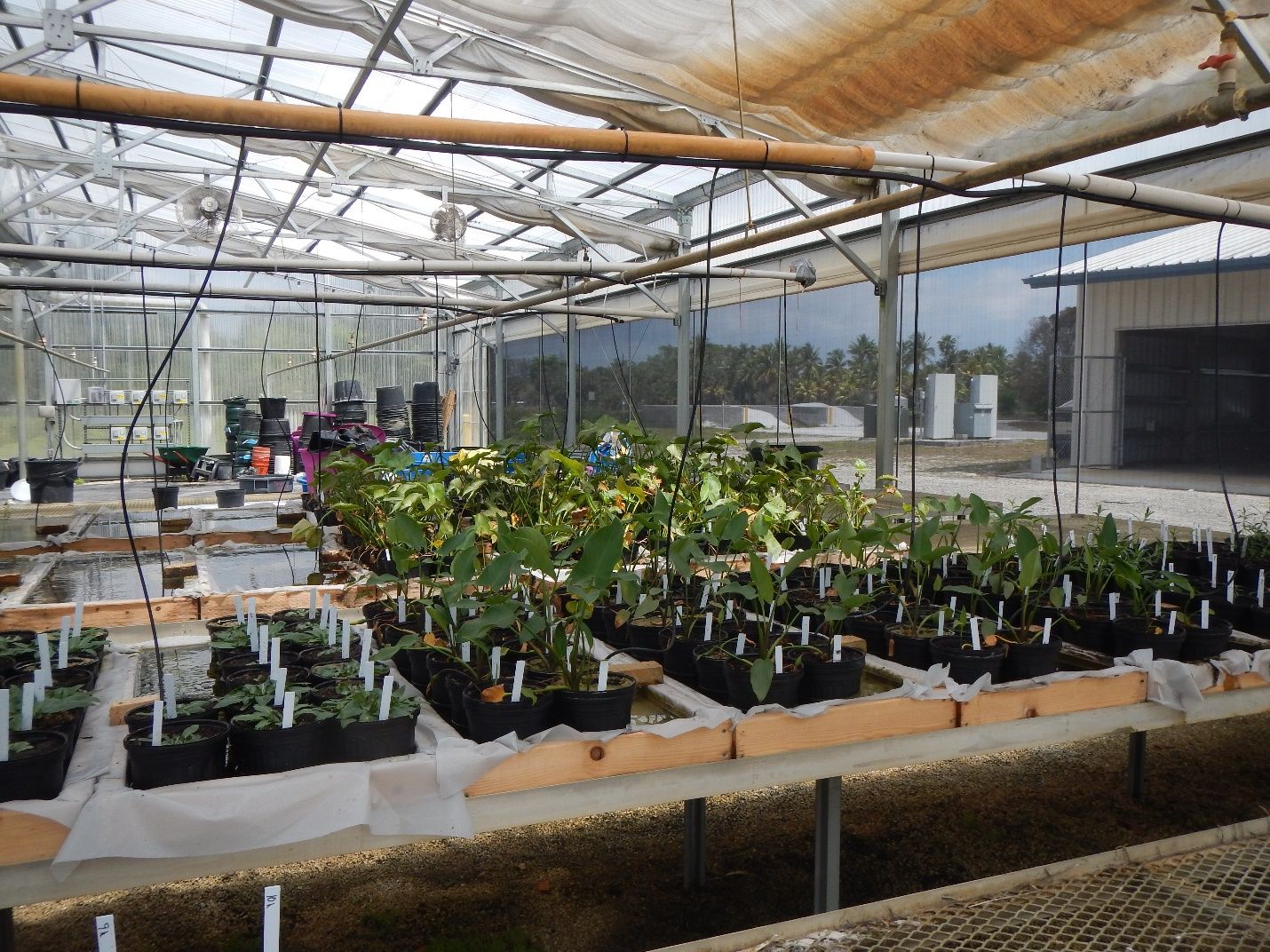
Credit: Lyn Gettys
Production facilities also need a storage area, or head house, for pots, soils, fertilizers, and other supplies. Each greenhouse, hoop house, or building should have its own head house, so plants and their associated equipment do not leave the building. This helps prevent the spread of pests and diseases. Each facility should also have a processing room where plants are prepared for distribution. This involves cleaning, pruning, and packaging. Adjacent to the processing room is a shipping room where packages are prepared for shipping, which varies by plant type. Packages are shipped in polystyrene foam boxes to ensure plants are kept at an appropriate temperature and protected from damage while in transit.
Diseases/Pests
Plants grown in an extensive, outdoor environment are more prone to infection and infestation then those grown under controlled conditions. Depending on production style, certain types of weeds can be more concerning than others. Emergent plant species are especially susceptible to terrestrial weeds because they are in less water and potted in soil. Nearby natural areas are vectors for weeds to enter an aquatic plant production facility. The spores or seeds of terrestrial weeds can enter a facility by wind or attached to worker clothing. Whereas submersed plant species may not get many terrestrial weed infestations, they can still become contaminated with submersed or floating nuisance species such as hydrilla (Hydrilla verticillata) and duckweed (Spirodela spp.).One of the best methods to get rid of weeds is to remove them by hand. This can be done while inspecting plants and helps to keep down weed populations. Herbicides can also be used to reduce overall weed levels within the general population if it is not detrimental to your plant crop.
Algae growth is more of an issue for submersed, floating-leaved, and floating plants than for emergent aquatic plants. High concentrations of nutrients cause algae to bloom within the water column, on the water’s surface, and on the surface of the plant itself. Algae reduces plant growth by blocking available light for photosynthesis and by absorbing available nutrients. To reduce algae in the water, use low-nutrient water and avoid overfertilization. Herbicides can also be used to reduce algae blooms buttake care not to harm the plant crop. It is important to address algae blooms immediately as they grow quickly.
Herbivores are quite damaging to freshwater plants. Whether they are turtles, waterfowl, or one or more of the numerous species of snails and insects that feed on aquatic plants, to grow freshwater plants successfully, you must remain vigilant to prevent infestations as much as possible and control any infestations that evade your prevention strategies. Larger vertebrates can decimate crops quickly but are maintained with physical exclusion devices and techniques designed to reduce exposure to plant crops. Although initially the effects of snails and insects can be less noticeable, once an infestation occurs, it is difficult to eliminate these pests completely from the facility. At that point you are continually managing a pest problem until it is permanently removed, which includes the use of a pesticide and a thorough sterilization of the building and its associated equipment. Take care to ensure that initial infestations do not occur or that they are dealt with before pest populations become too high.
When using herbicides and pesticides to control pest problems, it is essential to know the rules and regulations. Becoming a trained pesticide applicator or hiring one to address your pest issues is advantageous. For information about herbicide and pesticide use, please visit your local UF/IFAS Extension office or inquire at the UF/IFAS Pesticide Information Office, https://pested.ifas.ufl.edu and reference this publication on herbicide use, https://edis.ifas.ufl.edu/ag262.
Marketing
Marketing considerations depend on the types of freshwater ornamental plants being produced and the stage of growth they are in. Those facilities that only grow propagules, including tissue culture propagation, should focus on selling to producers who will continue to grow the product to market size. Identifying those facilities and developing a business relationship with those producers is essential. Producers who focus on providing a fully marketable product have a few avenues to explore. The first aspect to consider would be the industry they are providing for. Most aquatic plants are produced for the water garden and/or aquarium industries. If your facility is small, then you may want to explore local retailers who would be willing to sell your products. For aquarium plants, this would include pet stores that sell fish, plants, and aquarium supplies. For water garden plants, this would include plant nurseries, home improvement stores, and hardware stores where water gardening supplies are sold. It is also feasible to have a retail outlet at your facility but exclude visitors from production areas of the facility to maintain sanitary conditions and protect your plants. Direct to consumer online sales are also an excellent way to distribute product. However, selling online will likely increase your shipping expenses beyond the driving deliveries that you would make to local markets.
For larger facilities, it may be better to work with a wholesaler who is able to buy and sell most of what you produce. Wholesalers have a larger group of businesses that they provide for and will therefore be able to sell a higher volume of your product. Unfortunately, you will only be able to charge a wholesaler a fraction of the price you could charge if you sold directly to retail markets. However, as you increase in size the cost of production per unit will go down and you can make a larger profit even though you sell your plants for less. Understanding the cost of producing freshwater plants and the profit you gain from selling them will help you determine the best avenue for sales.
Conclusion
A large portion of freshwater ornamental aquatic plant production in Florida is through aquaculture techniques. Most of these species are grown for the water garden and/or hobby aquarium industries, with a smaller portion produced for food and wetland restoration. Florida’s warm, subtropical to tropical climate is ideal for growing freshwater ornamental aquatic plants during the entire year. This publication provides basic information on freshwater ornamental aquatic plant production in Florida.
References and Recommended Readings
Enloe, S. F., B. Sperry, J. Leary, and J. Ferrell. 2022. “Efficacy of Herbicide Active Ingredients Against Aquatic Weeds” SS-AGR-44/AG262. EDIS 2022 (3). https://doi.org/10.32473/edis-ag262-2022.
Flimlin, G., and D. Schnoor. 2004. “Establishing an Ornamental Aquatic Plant Culture Facility.” FS535. New Brunswick, New Jersey: Rutgers Cooperative Research & Extension.
Florida Department of Agriculture and Consumer Services, Division of Aquaculture. 2019. Aquatic Plant Aquaculture: Rules and Regulations. https://www.fdacs.gov/content/download/64120/file/FDACS-P-02058-Aquatic-Plant-Aquaculture_2019.pdf.
National Plant Board. 2014. National Plant Board. WordPress, database manager. National Plant Board. Last accessed: May 2020. Available: https://nationalplantboard.org/.
Ploeg, A., W. Tomey, R. Hensen, E. Mous, F. Riechelman, S. Willis, M. Sekharan, and B. McLane. 2014. International Transport of Aquatic Plants in the Ornamental Aquatic Industry. Ornamental Fish International (OFI), Maarssen, The Netherlands. 174 pp.
Tepoot, P. 1998. Aquarium Plants: The Practical Guide. New Life Publications, Homestead, Florida. 216 pp.
Table 1. Selected non-native freshwater aquatic plants that are regulated in Florida. Species on the Florida Noxious Weeds List may not be collected, cultivated, or sold under any circumstances. Prohibited Aquatic Plants may be cultivated for out-of-state sales with approval from FDACS-DPI. The complete Florida Noxious Weeds List is available at https://www.flrules.org/gateway/notice_Files.asp?ID=23639596.
Table 2.
| Prohibited Aquatic Plants | ||
| Growth habit | Common name | Latin name |
| Floating | Waterlettuce | Pistia stratiotes |
| Emergent/amphibious | Hygro, Miramar weed | Hygrophila polysperma |
| Submersed | Ambulia | Limnophila sessiliflora |